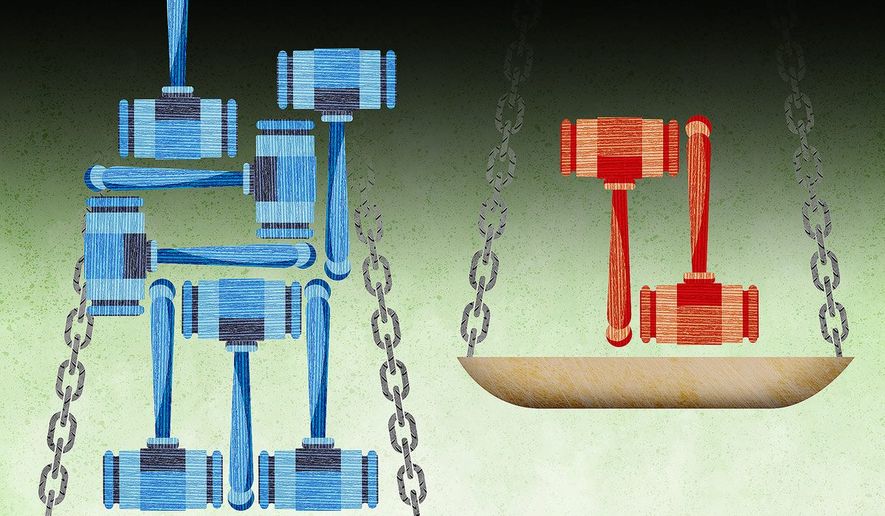OPINION:
As the 2020 presidential election unfolds, leftists agitate to make fundamental changes in our national institutions. Among them is packing the U.S. Supreme Court. By statute, a compliant Congress and a willing president can make the court as big as they want, to enforce their ideology.
Determined to neutralize Trump appointments, activists promote expanding the court to install sympathetic judges. Leading Democratic presidential candidates have reacted positively. Sen. Kamala Harris, California Democrat, claims the country is “on the verge of a crisis of confidence in the Supreme Court.” Adds the senator, “We have to take this challenge head-on, and everything is on the table to do that.”
For Ms. Harris, that includes court-packing. Sen. Elizabeth Warren, Massachusetts Democrat, argues this is a way to “de-politicize” the Court. Sen. Kirsten Gillibrand, New York Democrat, Mayor Pete Buttigieg, Indiana Democrat and former Rep. Beto O’Rourke, Texas Democrat, are open to the idea, and both Mr. Buttigieg and Mr. O’Rourke suggested it could be part of the Democratic Platform. Grassroots organizations like Demand Justice and Pack the Courts fuel this thinking.
If that seems vaguely familiar, it should. Early in 1937, President Franklin Roosevelt sought to pack the U.S. Supreme Court. Vexed by several rulings that declared New Deal legislation unconstitutional, Roosevelt considered constitutional amendments and legislation. Either would change the court’s membership to produce the kind of decisions Roosevelt wanted.
FDR settled on a clever fix. He asked Congress for legislation allowing a president to appoint up to six justices to serve alongside any justice over the age of 70 refusing to retire. This would allow Roosevelt to expand the Court to 15, packing it with enough friendly members to essentially guarantee he could dominate it. Prospects seemed bright. In 1937, Democrats held majorities in excess of three-quarters in both chambers. Roosevelt himself was fresh off a 1936 re-election campaign winning 46 of 48 states and securing over 60 percent of the popular vote.
On Feb. 9, 1937, Roosevelt tried to sell his plan to the country. In a Fireside Chat, he likened the three branches of government to a three-horse team. When all three horses pulled in the same direction, a field could be plowed. When they didn’t, it could not. By this reasoning, core constitutional concepts — checks and balances and separation of powers — were implicitly cast aside.
The American people recoiled. After extensive hearings, and eight days of floor debate, the Senate voted by 70 to 20 to kill the plan. FDR overreached. It was his most egregious political misjudgment, and the Senate rightfully resisted him.
As in 1937, the real purpose is an ideological power grab. The left frequently resorts to litigation to secure outcomes it cannot win through legislation or the ballot box. Packing the court will help them secure desired results on issues such as immigration, reproductive rights, environmental policy, health care and election reform.
At times, the court leans right; at other times it veers left. Due to lifetime appointments, its ideology can vary from the temporary political dominance of the other branches. Nevertheless, no president since Roosevelt has repeated his mistake and tried manipulating the court’s size in order to dominate it.
Legally, Congress can amend the law to expand or shrink the Court. However, what one has a right to do and what one should do are very different things. If restraint does not govern, independence of the judiciary will be imperiled. Transient majorities will pack the Court to secure momentary advantage. A Court of nine can soon become a court of 13, 15 or 21. In service of ideology, there is no limit.
Should Congress pursue this, not only the Supreme Court will change, so will the Senate. It is beyond probable that any legislation to pack the court would be filibustered. Proponents cannot win without destroying the filibuster as a tool of resistance. Not only would the effects on judicial independence be pernicious, the institution of the Senate as a home for free and robust debate would be irretrievably damaged.
In its 1937 report, the Senate Judiciary Committee exposed the true consequence of court-packing. “Its ultimate operation would be to make this Government one of men rather than one of law, and its practical operation would be to make the Constitution what the executive or legislative branches of the Government choose to say it is — an interpretation to be changed with each change of Administration.” The committee admonished, “It is a measure which should be so emphatically rejected that its parallel will never again be presented to the free representatives of the free people of America.”
Congress and the country must again heed this warning. New proposals to pack the Supreme Court are as illegitimate as the original and deserve a decisive rebuke. Especially in this era of hyper-partisan politics, we must vigilantly protect our governmental institutions. If we do not, those judicial and legislative structures will suffer grievously, and the frayed bonds holding our country together will further weaken.
• Martin B. Gold, a partner at Capitol Counsel, is the author most recently of the forthcoming”The Twenty-second Amendment and the Limits of Presidential Tenure.”




Please read our comment policy before commenting.